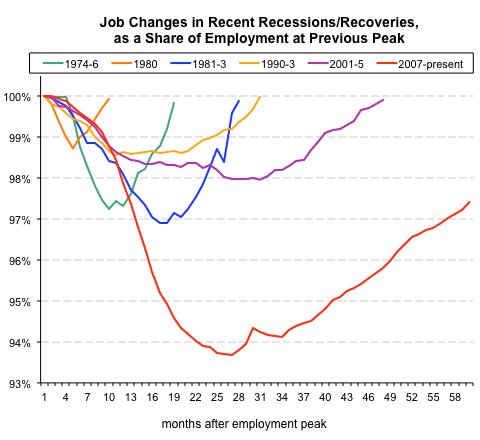 Source: Bureau of Labor Statistics.
Source: Bureau of Labor Statistics.

CATHERINE RAMPELL
Dollars to doughnuts.
For the 28th straight month, the country added jobs: 157,000 nonfarm payroll jobs in January, to be more precise.
But employment still has a long way to go before returning to its prerecession level.
The chart above shows economic job changes in this last recession and recovery compared with other recent ones; the red line represents the current cycle. Since the downturn began in December 2007, the economy has had a net decline of about 2.3 percent in its nonfarm payroll jobs. And that does not account for the fact that the working-age population has continued to grow, meaning that if the economy were healthy we should have more jobs today than we had before the recession.
Getting the economy to 5 percent unemployment within two years — a return to the rate that prevailed when the recession began — would require job growth of closer to 284,984 a month.
There are now 12.3 million workers looking for work who cannot find it. The tally of those who are underemployed — that is, adding in those workers who are part-time but want to be employed full-time, and workers who want to work but are not looking — is an even larger 21.4 million.
As bad as all these figures are, it’s worth remembering that job markets in the decade after a financial crisis are always terrible. In fact, layoffs were far worse and lasted much longer in the aftermath of the financial crises that struck, for example, Finland and Sweden in 1991 and Spain in 1977, not to mention the United States during the Great Depression.
Article source: http://economix.blogs.nytimes.com/2013/02/01/comparing-jobs-in-recessions-and-recoveries/?partner=rss&emc=rss
Speak Your Mind
You must be logged in to post a comment.